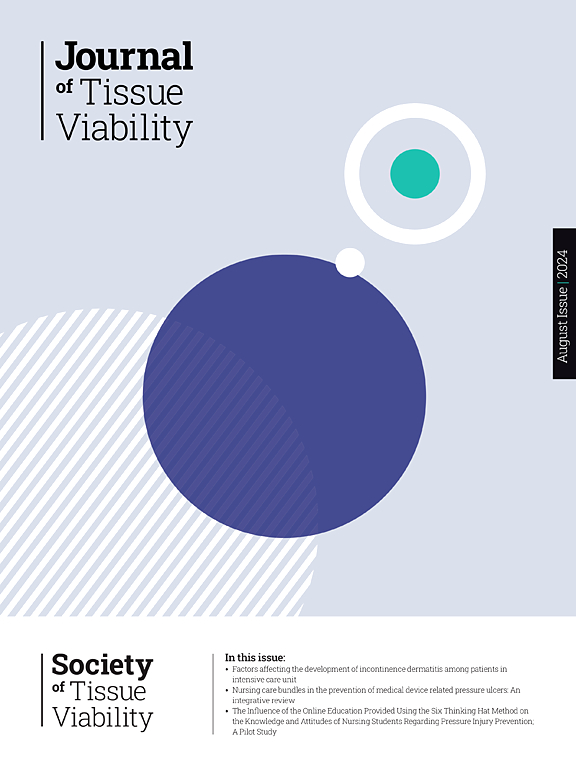Exploring resveratrol-enriched collagen dressings for diabetic foot ulcers: A retrospective study of wound healing outcomes
IF 2.4
3区 医学
Q2 DERMATOLOGY
引用次数: 0
Abstract
Background
Diabetic foot ulcers (DFUs) are a common and severe complication of diabetes mellitus, often leading to prolonged hospitalization, high treatment costs, and potential amputations. Despite advances in wound care, current dressing materials often lack bioactive properties to modulate chronic wound environments.
Aim
To evaluate the clinical efficacy of resveratrol-enriched collagen dressings compared to standard collagen dressings in the management of Wagner grade 2 diabetic foot ulcers.
Methods
This retrospective study included 41 patients with Wagner grade 2 DFUs treated at a diabetic foot clinic. Nineteen patients received resveratrol-enriched collagen dressings, while 22 received standard collagen dressings. Patients were matched based on age, glycemic control (HbA1c), and arterial supply (ABPI). Primary and secondary outcomes included wound size reduction, hospitalization duration, and dressing frequency. Statistical analyses included Student's t-test, Mann–Whitney U test, and Kaplan–Meier survival analysis.
Results
The resveratrol group demonstrated significantly greater wound size reduction (49.2 % ± 9.1 vs. 32.8 % ± 8.5; p = 0.021), shorter hospital stay (12.3 ± 2.8 vs. 14.5 ± 3.2 days; p = 0.045), and fewer dressing changes (19.8 ± 5.2 vs. 24.3 ± 6.7; p = 0.038). No adverse events were reported. Improved outcomes were attributed to resveratrol's antioxidant, anti-inflammatory, and antimicrobial effects.
Conclusions
Resveratrol-enriched collagen dressings significantly improved clinical outcomes in DFUs, suggesting a promising adjunctive treatment strategy. Further prospective studies are warranted to confirm these findings and explore long-term benefits.
探索富含白藜芦醇的胶原敷料用于糖尿病足溃疡:伤口愈合结果的回顾性研究
背景:糖尿病足溃疡(DFUs)是糖尿病常见且严重的并发症,通常导致住院时间延长,治疗费用高,并可能导致截肢。尽管在伤口护理方面取得了进步,但目前的敷料往往缺乏调节慢性伤口环境的生物活性特性。目的评价富含白藜芦醇的胶原蛋白敷料与标准胶原蛋白敷料治疗Wagner 2级糖尿病足溃疡的临床疗效。方法回顾性研究41例在糖尿病足门诊治疗的Wagner 2级DFUs患者。19例患者使用了富含白藜芦醇的胶原蛋白敷料,22例患者使用了标准胶原蛋白敷料。患者根据年龄、血糖控制(HbA1c)和动脉供应(ABPI)进行匹配。主要和次要结局包括伤口缩小、住院时间和包扎次数。统计分析包括学生t检验、Mann-Whitney U检验和Kaplan-Meier生存分析。结果白藜芦醇组创面缩小明显(49.2%±9.1比32.8%±8.5,p = 0.021),住院时间明显缩短(12.3±2.8比14.5±3.2天,p = 0.045),换药次数明显减少(19.8±5.2比24.3±6.7,p = 0.038)。无不良事件报告。改善的结果归因于白藜芦醇的抗氧化、抗炎和抗菌作用。结论富含白藜芦醇的胶原蛋白敷料可显著改善DFUs的临床结果,提示有希望的辅助治疗策略。需要进一步的前瞻性研究来证实这些发现并探索其长期益处。
本文章由计算机程序翻译,如有差异,请以英文原文为准。
求助全文
约1分钟内获得全文
求助全文
来源期刊

Journal of tissue viability
DERMATOLOGY-NURSING
CiteScore
3.80
自引率
16.00%
发文量
110
审稿时长
>12 weeks
期刊介绍:
The Journal of Tissue Viability is the official publication of the Tissue Viability Society and is a quarterly journal concerned with all aspects of the occurrence and treatment of wounds, ulcers and pressure sores including patient care, pain, nutrition, wound healing, research, prevention, mobility, social problems and management.
The Journal particularly encourages papers covering skin and skin wounds but will consider articles that discuss injury in any tissue. Articles that stress the multi-professional nature of tissue viability are especially welcome. We seek to encourage new authors as well as well-established contributors to the field - one aim of the journal is to enable all participants in tissue viability to share information with colleagues.
 求助内容:
求助内容: 应助结果提醒方式:
应助结果提醒方式:


